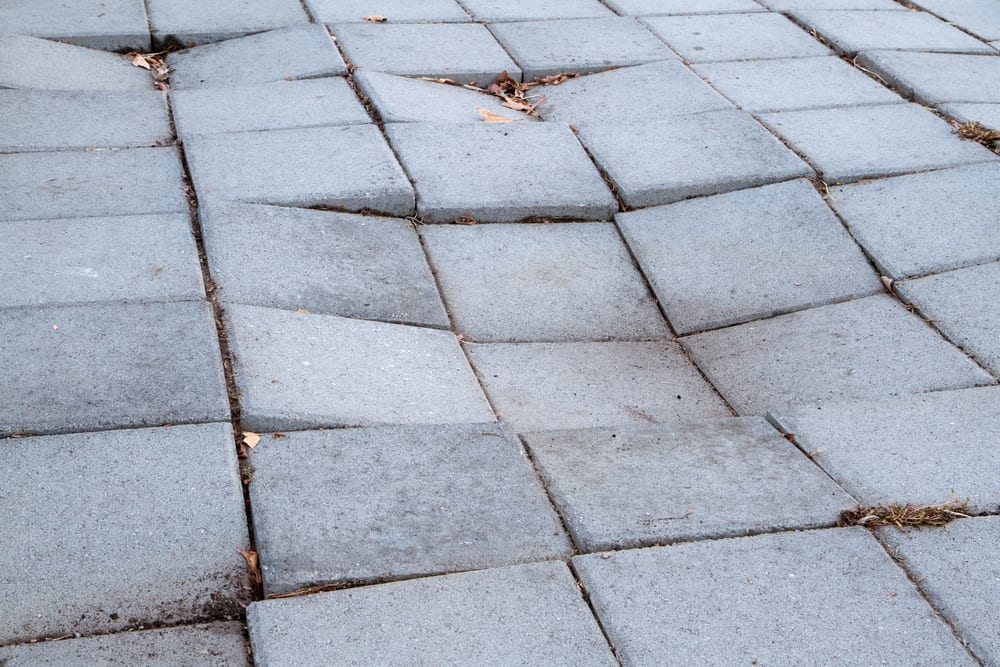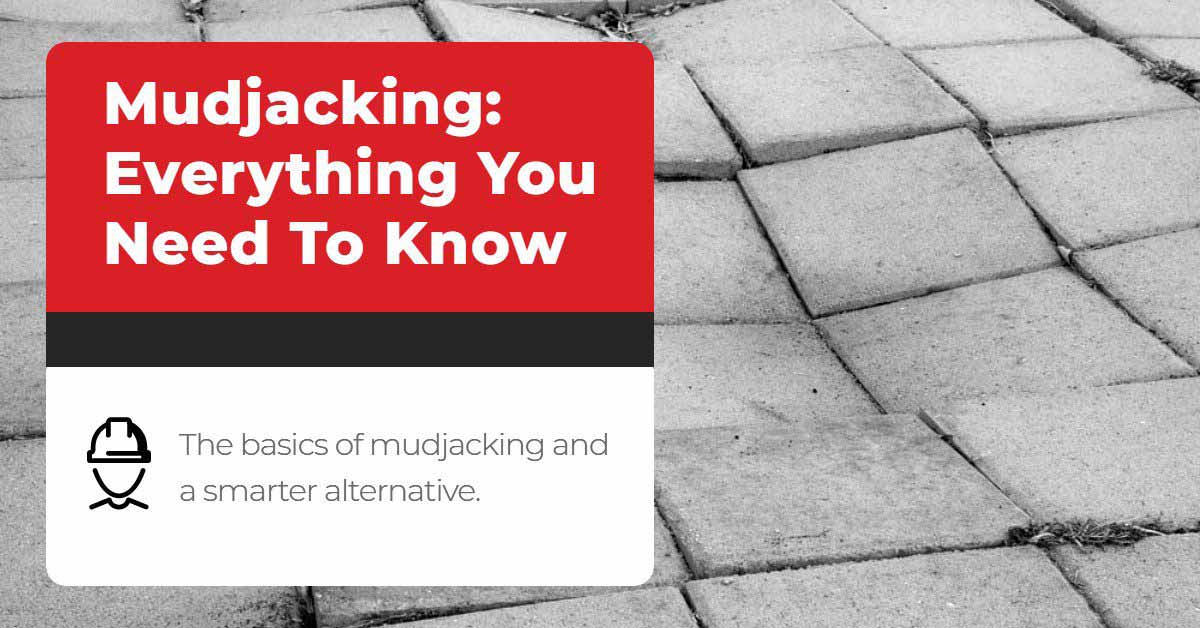If you’re searching for mudjacking, you probably have a sinking concrete slab. Uneven concrete slabs such as sidewalks, driveways, pool decks, patios, and floors are not only eyesores, they’re also a safety liability that could result in injuries and even lawsuits.
The old school technique of fixing uneven concrete slabs was to simply dig them up and replace them by pouring new concrete. This was both expensive and time consuming. There was also the downtime waiting for the new slab to dry and harden. To top it off, matching the color of the new slab to the concrete that wasn’t replaced was next to impossible. in other words, tearing up the uneven concrete and pouring a new slab wasn’t an invisible repair.
Therefore, raising the slab became a better option, first via a technique called mudjacking and later via polyurethane foam injection. Both techniques involve drilling holes into the slab and then injecting a material to fill the voids and lift the slab.

But first of all….
Why do concrete slabs sink and become uneven?
Concrete slabs sink for a variety of reasons including problems with drainage, expansive tree roots, and expansive soil.
Expansive soil is soil that swells when it gets wet, and shrinks when it dries out. This back and forth swelling and shrinking is seasonal and causes the soil to move. This can, over time, destabilize any concrete slab sitting on top of expansive soil.
Drainage problems can cause too much water to get under the slab and wash away the soil holding it up. Voids form and the slab starts to sink.
You can probably visualize how expansive tree roots can destabilize a concrete slab such as a sidewalk. Not only can they physically push against the slab, but they can also soak up moisture from the soil causing it to shrink and eventually leading to the formation of voids under the slab.
What is mudjacking?
Mudjacking has been around for about 75 years now, and is used to lift sunken concrete slabs such as sidewalks, patios, pool decks, and driveways. The process involves injecting a cement slurry – usually a mix of water, soil, and cement – under the slab in order to lift it back up again. It’s a quick repair and can often be completed in just a few hours.
Note: Mudjacking is used to lift and level concrete slabs only. It cannot be used to lift foundations. Also, mudjacking is used to raise intact concrete slabs. If a slab has been severely damaged, mudjacking won’t help. The slab will need to be torn up and replaced with a new one.
Is mudjacking the same as slabjacking?
When people in the foundation repair industry use the term ‘’slabjacking’’ they are typically referring to the polyurethane foam injection method of lifting a concrete slab. However, the term ‘’slabjacking’’ technically refers to any repair method that lifts a concrete slab via injecting a material underneath it.
How mudjacking works?
Mudjacking involves drilling several holes – about 1.5”-2.5’’ in diameter – into the slab. A cement slurry usually consisting of water, sand, and cement is then injected under the slab via the holes. It fills any voids and as the pressure builds, it lifts the slab back up to where it was before. The holes are then filled to match the existing grade, and the repair is complete. Once the concrete has cured properly – this usually takes 24 hours – the slab will be ready for use again.
The pros and cons of mudjacking
Pros
- Mudjacking is less expensive that replacing the concrete slab because you don’t need to remove the old slab and pour a new one.
- Mudjacking is an environmentally-friendly green solution because the slurry injected under the concrete is a mix of water, sand and cement.
- Mudjacking is a quick repair. Most jobs can be completed in just a few hours.
- Mudjacking is an easy repair that doesn’t require any heavy equipment or a large crew.
Cons
- The holes required for mudjacking are larger than those required for polyurethane foam injection because the cement slurry is bulky.
- The cement slurry used in mudjacking is also heavy. If the slab sunk because the soil wasn’t able to support it, adding even more weight isn’t going to help. In fact, it could even cause the slab to further sink into the ground because of the added weight. (The cementitious mud used for mudjacking typically weighs from 90 to 125 lbs./cubic foot.)
Why polyurethane foam injection is a better than mudjacking for lifting a sunken concrete slab
Polyurethane foam injection started being used back in the 1980s to repair/fill voids in roads and highways. Today, it’s still used to repair roads, but also sidewalks, driveways, pool decks, patios, sinkholes and more. If you need to lift a sunken concrete slab, polyurethane foam injection is a favored option over mudjacking for a variety of reasons including:
- It’s a minimally-invasive procedure that does not require digging or excavation.
- While both mudjacking and polyurethane foam injection require drilling holes in the concrete, the holes necessary for polyurethane foam injection are much smaller, only around 5/8’’ in diameter compared to the 1.5”-2.5’’ holes necessary for mudjacking. The larger holes necessary for mudjacking not only look bad, but they also compromise the integrity of the slab. There’s a chance that cracks could appear after the mudjacking procedure.
- Polyurethane foam is extremely lightweight when compared to the heavy cement slurry used in mudjacking. The unit weight for polyurethane grout typically used for slab lifting ranges from 2.0 to 6.0 lbs./cubic foot.
- Around 15 minutes after the the polyurethane foam injection procedure is complete, the slab is ready for use again. In contrast, you’ll need to wait about 24 hours to use the slab again after mudjacking.
- Polyurethane foam is under the slab to stay. It will not wash away, shrink, or lose its density and bonds well to soil particles.
While polyurethane foam injection does cost more than mudjacking, it’s less expensive than tearing up a slab and replacing it with a new one. Also, like mudjacking, polyurethane foam is an environmentally-friendly green solution. Most polyurethane products used for slab raising are inert and harmless to our environment and are ANCI/NSF certified for use in potable water tanks.
How does polyurethane foam injection work?
Polyurethane foam injection is a simple, 3-step process:
1. Small, 5/8 inch diameter holes – strategically placed – are drilled in the concrete slab.
2. The polyurethane foam is injected into the holes in order to lift the concrete slab back up to where it was before. The foam is pumped in as a liquid, but then rapidly expands in order to fill the voids and raise the slab.
3. The holes are filled, and in about 15 minutes the slab will be ready for use again
Tearing up a sunken concrete slab and then replacing it by pouring new concrete is expensive and time-consuming. Therefore, repairing an intact slab is always going to be the better option. The question then is, which is better, mudjacking or polyurethane foam injection?
Read more about – Concrete slab cracks in Florida home.
While mudjacking is a less expensive than replacing a concrete slab, it has some serious drawbacks, including the fact that adding more heavy cement to soil that’s already having trouble supporting a slab isn’t going to solve the problem. In fact, it could make it worse. This is why we recommend polyurethane foam injection for raising sunken concrete slabs.
Have a sunken concrete slab that needs lifting and leveling? Contact us today for a free inspection and estimate.




